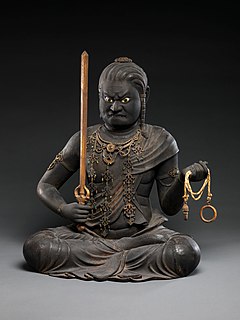
Back أكالا Arabic མི་གཡོ་བ། Tibetan Acala Catalan Acala German Acala (deidad) Spanish Ācala Basque Acala French Acsala Hungarian Acala (buddismo) Italian 不動明王 Japanese
This article should specify the language of its non-English content, using {{lang}}, {{transliteration}} for transliterated languages, and {{IPA}} for phonetic transcriptions, with an appropriate ISO 639 code. Wikipedia's multilingual support templates may also be used. (December 2021) |
| Acala | |
|---|---|
 Statue of Fudō Myōō (Acala), from early 13th century (Kamakura period) Japan | |
| Sanskrit |
|
| Chinese |
|
| Japanese |
|
| Korean | 부동명왕 (Budong Myeongwang) |
| Mongolian | Хөдөлшгүй (Khödölshgüi) |
| Tibetan | མི་གཡོ་བ་ (Miyowa) |
| Vietnamese | Bất Động Minh Vương |
| Information | |
| Venerated by | Vajrayana Buddhism, Mahayana Buddhism, Shugendō |
| Attributes | vajra, lasso (pāśa), khanda |
Acala or Achala (Sanskrit: अचल, "The Immovable", IPA: [ˈɐt͜ɕɐlɐ]), also known as Acalanātha (अचलनाथ, "Immovable Lord") or Āryācalanātha (आर्याचलनाथ, "Noble Immovable Lord"), is a wrathful deity and dharmapala (protector of the Dharma) prominent in Vajrayana Buddhism and East Asian Buddhism.[1]
Originally a minor deity described as a messenger or acolyte of the buddha Vairocana, Acala later rose to prominence as an object of veneration in his own right as a remover of obstacles and destroyer of evil, eventually becoming seen as the wrathful manifestation of either Vairocana, the buddha Akṣobhya, or the bodhisattva Mañjuśrī. In later texts, he is also called Caṇḍaroṣaṇa (चण्डरोषण, "Violent Wrathful One", IPA: [t͜ɕɐɳɖɐˈroːʂɐnɐ]) or Caṇḍamahāroṣaṇa (चण्डमहारोषण, "Violent One of Great Wrath", IPA: [t͜ɕɐɳɖɐmɐɦaːˈroːʂɐnɐ]), the names by which he is more commonly known in countries like Nepal and Tibet.[2][3][4]
In East Asian esoteric Buddhism, Acala is classed among the Wisdom Kings (Vidyārāja) and is preeminent among the five Wisdom Kings of the Womb Realm. Accordingly, he occupies an important hierarchical position in the Mandala of the Two Realms. In China, he is known as Bùdòng Míngwáng (不動明王, "Immovable Wisdom King", the Chinese translation of Sanskrit Acala(nātha) Vidyārāja[5]), while in Japan, he is called Fudō Myōō, the on'yomi reading of his Chinese name.[6] Acala (as Fudō) is one of the especially important and well-known divinities in Japanese Buddhism, being especially venerated in the Shingon, Tendai, Zen, and Nichiren sects, as well as in Shugendō.
Acala has been worshiped throughout the Middle Ages and into modern times in Nepal, Tibet, China and Japan, where sculptural and pictorial representations of him are most often found.[1][3]
- ^ a b Murakami 1988, Jp. rel. dict., pp. 242–246
- ^ Weston, David (2018). "The Bayer Collection — University of Glasgow" (PDF). The Bayer Collection. Archived from the original (PDF) on 23 August 2021. Retrieved 18 December 2019.
- ^ a b Donaldson, Thomas E. (2001). Iconography of the Buddhist Sculpture of Orissa: Text. Indira Gandhi National Centre for the Arts. pp. 219–221. ISBN 978-0-486-25575-0.
- ^ Hugo Kreijger (1999). Kathmandu Valley painting: the Jucker collection. Shambhala. p. 123. ISBN 978-1-57062-454-4.
- ^ Goble, Geoffrey C. (2019). Chinese Esoteric Buddhism: Amoghavajra, the Ruling Elite, and the Emergence of a Tradition. Columbia University Press. p. 65. ISBN 978-0-231-55064-2.
- ^ Fudō Myōō and Myō-ō, Encyclopædia Britannica
© MMXXIII Rich X Search. We shall prevail. All rights reserved. Rich X Search